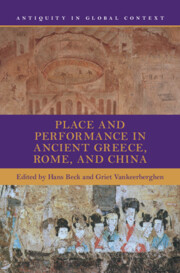Book contents
- Place and Performance in Ancient Greece, Rome, and China
- Antiquity in Global Context
- Place and Performance in Ancient Greece, Rome, and China
- Copyright page
- Contents
- Figures
- Tables
- Contributors
- Series Editors’ Preface
- Editors’ Preface
- Introduction
- Part I Crafting Space and Place
- Part II Performances of Power
- Part III Urban Places
- Part IV Fringe Places and Endpoints
- Chapter 11 Imitating the Emperor?
- Chapter 12 Traces of Han and Roman Frontiers
- Chapter 13 Money and the Dead
- Chapter 14 Displaying the Dead
- Index
- References
Chapter 11 - Imitating the Emperor?
Cities and Client Kings in the Hellenistic East and the Western Regions of the Han Realm
from Part IV - Fringe Places and Endpoints
Published online by Cambridge University Press: 28 November 2024
- Place and Performance in Ancient Greece, Rome, and China
- Antiquity in Global Context
- Place and Performance in Ancient Greece, Rome, and China
- Copyright page
- Contents
- Figures
- Tables
- Contributors
- Series Editors’ Preface
- Editors’ Preface
- Introduction
- Part I Crafting Space and Place
- Part II Performances of Power
- Part III Urban Places
- Part IV Fringe Places and Endpoints
- Chapter 11 Imitating the Emperor?
- Chapter 12 Traces of Han and Roman Frontiers
- Chapter 13 Money and the Dead
- Chapter 14 Displaying the Dead
- Index
- References
Summary
The chapters in this final part deal with places that permeate peripheries and accentuate endpoints – of individuals and of states. Their focus is, first, on how borders were experienced as markers of the confines of one civilization and zones of transition to another and, second, what types of performance were established to deal with the existential crisis of death. Alex McAuley begins with the discussion of the Hindu Kush region, typically considered a realm in between: at its most western stretches, the city of Ai Khanoum has been labelled an outpost of Hellenism, while in the east, the city of Dunhuang in today’s Gansu province is understood as a fringe settlement on the edges of the Western Han. Traditional views of centre and periphery highlight the remoteness of both sites from the cultural core of their civilization and the corresponding centres of political authority. McAuley, too, asserts that the cultural traditions of Ai Khanoum and Dunhuang were designed to stand out from their environments. He takes this distinction as indicative of a peculiar dynamic between imperial centre and periphery, and between place and political culture. Seleucids and Western Han established remarkably similar mechanisms to link distant reaches to their domain. McAuley explores two means in particular: the strengthening of imperial integration through urban connections and designs, and the establishing of dynastic networks that linked client kings to the central core. Prevailing orthodoxies view these measures from the centre. McAuley’s chapter distinguishes itself by bringing local experience on the periphery to life, that is, by demonstrating how the central regions of empire, around Chang’an and the Seleucid tetrapolis, were transported by these measures to the edge of empire, where they wielded their own dynamic in place – and whence they radiated back to the imperial court. Effectively, this chapter not only enriches perspectives on the Hellenistic world and Han China from the vantage point of the Hindu Kush but also demonstrates how the imperial frontiers of both civilizations overlapped in Central Asia, suggesting that the divide between East and West in antiquity is shrinking.
- Type
- Chapter
- Information
- Place and Performance in Ancient Greece, Rome, and China , pp. 349 - 377Publisher: Cambridge University PressPrint publication year: 2024

